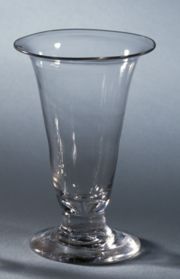Short Plain Jelly Glasses
Artist/Maker: Unknown
Created: late 18th century
Origin/Purchase: England
Materials: glass
Dimensions: H: 10 (3 15/16 in.); D (rim): 6.5 (2 9/16 in.)
Location: Dining Room
Provenance: Thomas Jefferson; by descent to Margaret Randolph Taylor and Olivia Alexander Taylor; by bequest to the Thomas Jefferson Foundation in 1985
Accession Number: 1986-31-10
Historical Notes: At the end of his stay in France, Jefferson copied several of his favorite recipes. One of them explained how to make "Wine jellies." Boiled calves-feet or isinglass was combined with egg whites and a pint of madeira. The mixture was sweetened and flavored with lemon, cloves and nutmeg. "Strain it 2 or 3 times thro' a flannel till clear," wrote Jefferson; then, "Put it in glasses or moulds."[1]
In the eighteenth and early nineteenth century, the second course of dinner typically featured a number of sweet dishes such as cakes, custards, creams, and jellies. Although sometimes made in large, elaborate molds, jellies served in individual glasses were equally popular. Round, trumpet-shaped, and footed jelly glasses corresponded to other fashionable glassware in shape and decoration.[2]
Three different styles of Monticello glasses are known. Two are plain free-blown glasses, one with a knopped stem. A third type of free-blown jelly glass has cut decoration on the rim and bowl.
On August 18, 1791, in New York, Jefferson wrote in his memorandum book, "Pd. for jelly glasses 3. doz. 3 [dollars]."[3] Among the items inventoried at Monticello after his death were "21 cut & 3 plain jelly glasses."[4]
-Text from Stein, Worlds, 339
References
- ^ Jefferson, "Wine jellies," undated, Thomas Jefferson Papers, Library of Congress.
- ^ Louise Conway Belden, The Festive Tradition: Table Decoration and Desserts in America, 1650-1900 (New York: W.W. Norton & Co., 1983), 55, 158.
- ^ Jefferson, August 18, 1791, in MB, 2:830. Transcription available at Founders Online.
- ^ [Martha Jefferson Randolph?], "Inventory of the furniture in the house at Monticello," Coolidge Collection of Thomas Jefferson Manuscripts, Massachusetts Historical Society.
